Advances muscle; arthritis; NMJ
1/30
Earn XP
Description and Tags
Exam 3
Name | Mastery | Learn | Test | Matching | Spaced |
|---|
No study sessions yet.
31 Terms
For Exam III
Calcitonin lowers blood calcium and stimulates the osteoblasts- NOT “calmodulin” which is a blood protein that transports calcium (in the blood)
calcitonin is 1st of 5 hormones involved in bone remodeling
calmodulin is not a bone remodeling hormone, it is an intracellular calcium binder that plays a lot of different roles in intracellular signaling… binds Ca++ intracellularly = cell signaling, not one of 5 hormones associated with bone remodeling
Review “excrete vs secrete” and “endocrine vs exocrine”
excrete = waste, secrete = everything else. endocrine = goes into blood; prob. a hormone, exocrine = anywhere else
-crine in Greek is secrete
REVIEW (old material)
epiphyseal growth plates
skin (epidermis & dermis)
sweat that dissipates heat: sweat gland secretion
if there’s excess ions or some other waste that is in the fluid… excrete
Dr. Cinnamon VanPutty: sweat from skin & urine is the same (wrong)
sudor in Latin is sweat… sudoriforous glands are going to secrete
broken bones
ref. to cancer
5 types of antibodies
Joint Disease (Rheumatoid arthritis)
Rheumatoid arthritis (RA) is a long-term autoimmune disorder **(antibody or Ig) 5 types/classes of Ig (M, A, D, E, & G) that primarily affects joints. It typically results in warm, swollen, and painful joints. Pain and stiffness often worsen following rest. Most commonly, the wrist and hands are involved, with the same joints typically involved on both sides of the body. NOTE- we have studied dendritic cells **(antigen presenting cells) before!
autoimmune: auto → self
antigens are foreign particles, Ig attaches to it, macrophages come in & devour whole thing
NOTE- **dendritic cells are typically found in high numbers within a tumor
T cells (T-lymphocytes) & B cells (B-lymphocytes)
T-lymphocytes differentiate in thymus
B-lymphocytes differentiate into plasma cells… plasma cells make antibodies
Know that macrophages & dendritic cells are antigen presenting cells (APC’s)
macrophages: macro → big
phages: phago in Greek → eat
^^ BIG EATERS
antigen is something foreign that gets presented as part of integrated immune defense system to ramp up immune response
dendritic cells oftentimes found in high #’s, found w/in heavy concentration in tumors
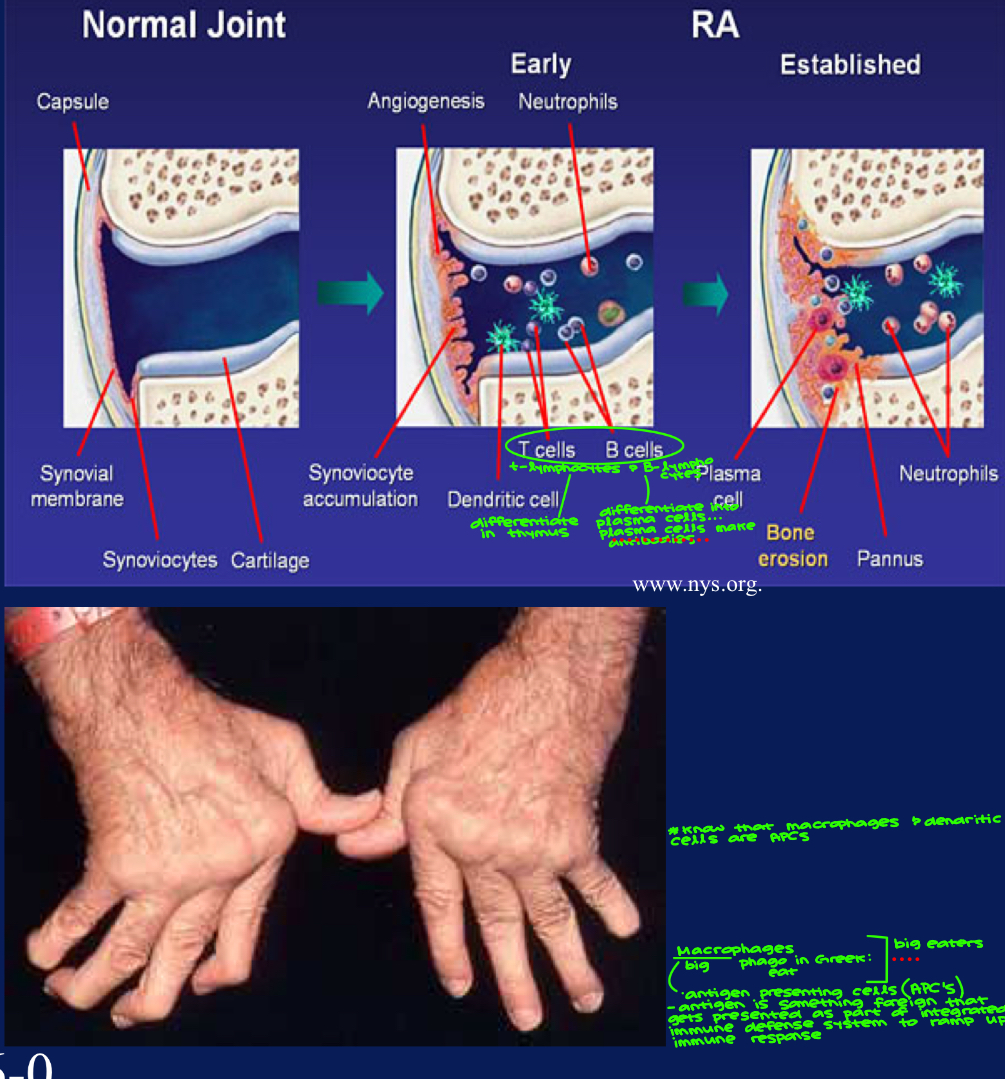
Osteoarthritis (Joint Disease)
An **impingement** C.P.L = HIPS!! Femoral Acetabular Impingement (genetic)
impingement: in there too tight
CPL wasn’t bone on bone until 35
Progressive thinning of ****hyaline cartilage
leads us back to articular cartilage (ends of epiphyses)
articular cartilage is a type of hyaline
a lot of times cartilage is not heavily innervated w/ circulatory system, some of these cells are 6-8 cell links away from a capillary bed which means they don’t heal very quickly
the further that we have tissues away from capillary beds, the less blood flow they receive, the slower they are to heal
Formation of **osteophytes** (a bone outgrowth! = **”bone spurs'“** of the heel)** exacerbate = Makes it WORSE!
osteophytes: sometimes during bone remodeling, there’s these little extensions that come off, prominent in heel… can rub against calcaneal tendon, which inserts on calcaneus
bone spurs = no good
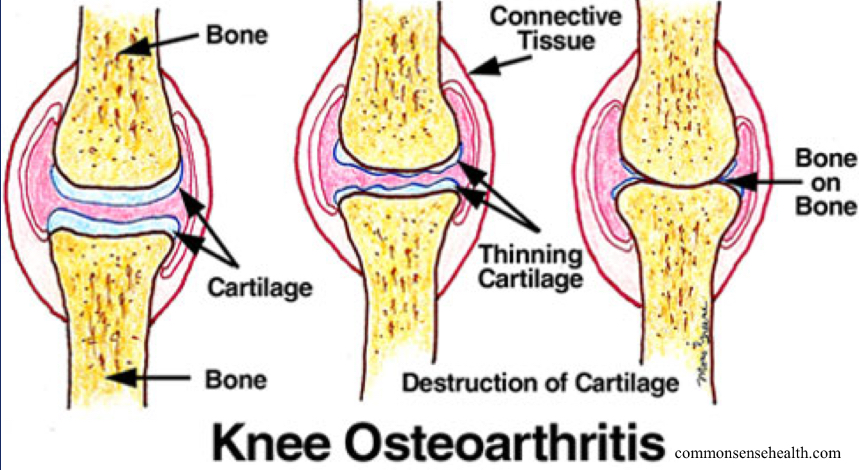
Pen & paper
Thalamus + hypothalamus = diencephalon of forebrain
Hypothalamus (under thalamus), works with master gland (pituitary)
Portal system = Blood (AP) encounters TWO cap beds BEFORE blood returns to the heart = Portal Sys
Hypothalamic- hypophyseal system
(Anterior pituitary); Hormones made & WHERE are the released from; AP = made & released
anterior pituitary hormones made & released from anterior pituitary
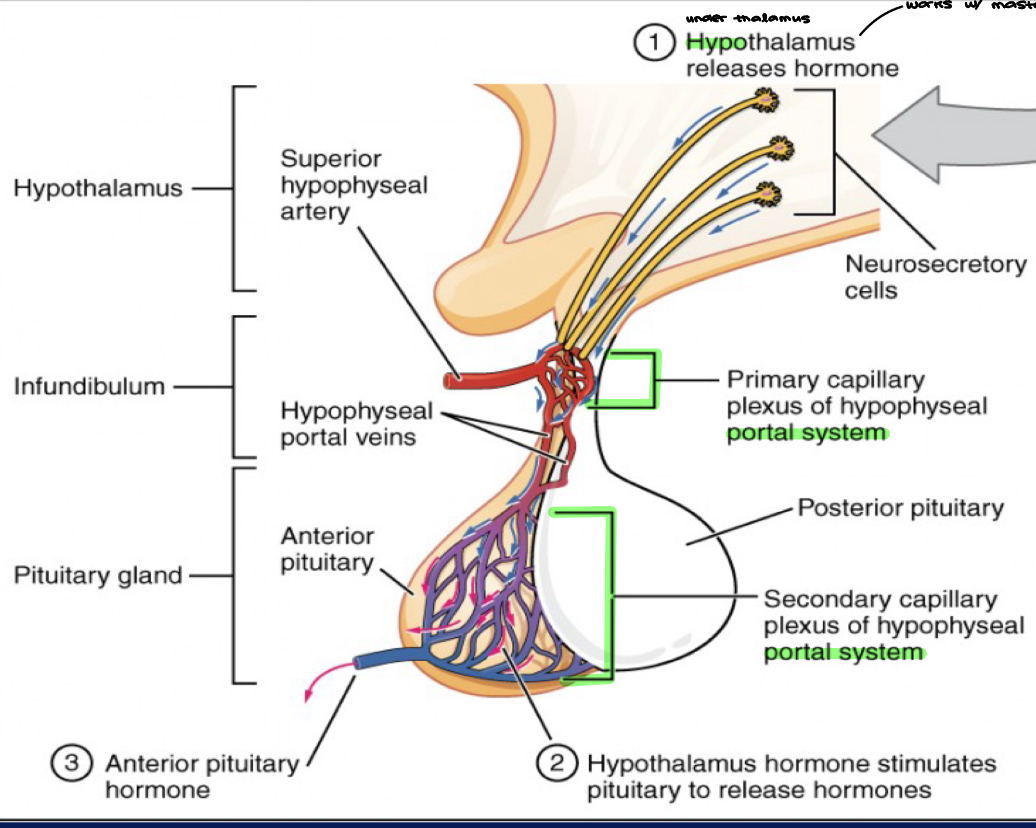
Review after Exam II
Diuresis = urine formation; Dehydration!! when one consumes alcohol
“FLAT PEG” from anterior pituitary! “E” = Endorphins (natural pain killers)
FLAT PEG made & released from anterior pituitary
FSH → follicle stimulating hormone, LH → leutinizing hormone, ACTH → adrenocorticotropin hormone, TSH → thyroid stimulating hormone, P → prolactin, E → endorphins, GH → growth hormone
Posterior pituitary
neuroendocrine neurons… posterior pituitary hormones are not made at the level of posterior pituitary
made at soma (body of a neuron)… site of all biosynthesis w/in neurons collectively known as a nerve
Oxytocin: made in hypothalamus, vessicalized & sent via rotary proteins. Sperm transport in males, milk letdown in nursing females. Associated w/ uterine contractions associated w/ childbirth (parturition)
Vasopressin aka the ADH; vasopressin ADH levels up, Urine volume goes down! NOTE- Caffeine (-) ADH; C2H5OH (-) ADH
has 3 names
ADH: anti-diuretic hormone… against urine formation. ADH increases, urine volume decreases. If dehydrated, ADH up, urine volume down, color of urine is dark… don’t want to lose fluid
caffeine and ethanol (2 carbons) inhibit ADH
drink a lot of coffee, don’t make urine… urine volume increases
drunk people make lots of urine
ethanol is the only alcohol our liver can metabolize
color of urine when drunk = clear
combine both = lots of urine
ADH & oxytocin made in hypothalamus → inverses

or Gouty Arthritis (Joint Gout Disease)
What is gout??? Deposition of needle-like crystals of uric acid into joints! Diet matters, genetics matter and under-excretion of uric acid by the kidney are ALL factors!
nitrogenous waste, mostly from the metabolism of the broken down aa… if we cannot get rid of all of them w/ the kidney, these nitrogenous waste we need to get rid of, we need to excrete them
these nitrogenous wastes, usually from the bio-metabolism of aa, if we cannot get rid of all of them they will crystallize
gravity takes over & these uric acid crystals make their way into our lower extremities
uric acid crystals start to accumulate in our feet
diet matters, genetics matter
NOT turf toe!
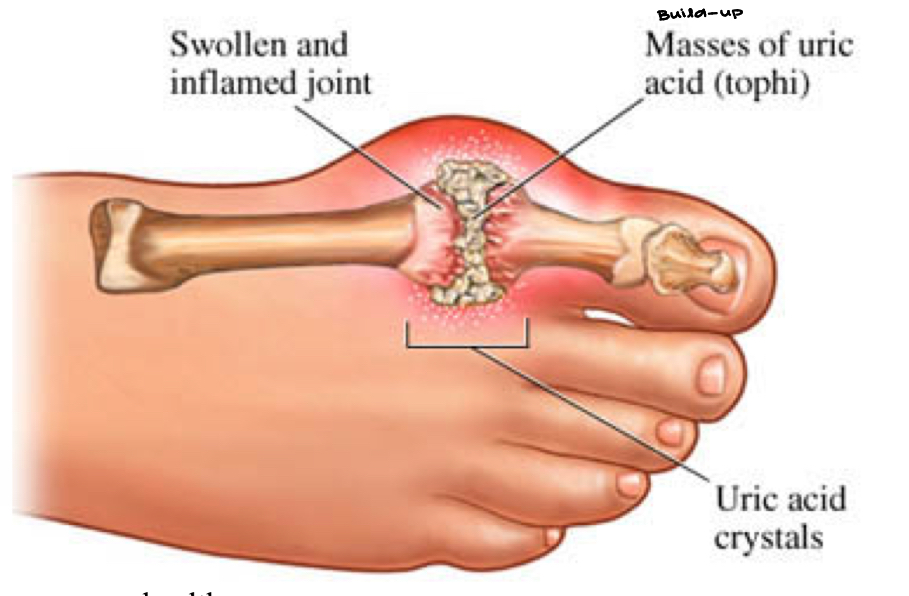
Skeletal Muscle
Function
Movement- produce tension to move things pulling, squeezing
Posture- baseline tension exerted at all times
Joint stability- constant tension holds joints together… Non-usage → muscle atrophy → less stable; **Atrophy is the opposite of hypertrophy
^^^everyone is going to get these, basic fxn
**Thermogenesis (heat!) = Shiver; NOTE shivering is involuntary
shivering & reflexes are not always involuntary
Source of nutrition!! (***Starvation); developed large muscle → NOT maintained); **Glutamate (AA) = “savory” = meat Umami! is the most-prevalent AA in SM (higher vertebrates)
through non-usage, body atrophy’s
starvation: 1st scenario where our skeletal muscle becomes a source of nutrition
somebody builds a muscle, stops using it → nutrition source
umami is 5th receptor, Japanese word for savory
glutamate is the most prevalent aa
Muscle cell (fiber) characteristics
2 excitable tissues **(RMP → AP)- respond to chemical & mechanical stimuli by generating organized movement of electrical charge across membranes: =muscle potentials or action potentials
muscle, epithelial, connective, nervous → all 4 have RMPs
nervous & muscle → can generate APs
non-muscle ref. to actin: leads to amoeboid movement, cells can move… diapedesis, which means they get out of capillary beds. Prob. a cancer, can move which means it can metastisize
**Contractile-shortening (sliding filament theory = actin & myosin do NOT shorten)
muscle ref. to actin
Extensible- tolerate stretching
Elastic- snap back into position after stretch
***Generates heat (shivering is involuntary skeletal muscle activity)!!!
Skeletal muscle fibers can be classified based on two criteria: 1. How fast do fibers contract relative to others. 2. How do fibers regenerate ATP? *****Genetic Component; **Cultural (geography) = ***Founder Effect
**Type 1**: Slow oxidative = O2; (SO) fibers contract relatively slowly & use aerobic respiration (oxygen & glucose) to produce ATP. They produce low power contractions over long periods & are slow to fatigue (NT, ATP, pH issue = FATIGUE?). **Marathon; ADD = less force’ more mitochondria and more capillary density
duck dynasty has this genetic disposition/propensity… runners high
**Type 2A: Fast oxidative (FO) fibers have fast contractions & primarily use aerobic respiration, but because they may switch to anaerobic respiration (glycolysis), can fatigue more quickly than SO fibers
**Type 2B: Fast glycolytic (FG) fibers have fast contractions & primarily use *anaerobic glycolysis. The FG fibers fatigue more quickly than the others; SPRINTERS!! Opposite of Type 1
fast twitch fibers
gly: sugar/sweet
-lytic: break
Jamaica, founder’s effect
Pretty much all humans have all 3
54 countries in Africa… Kenya well known for their marathon runners
Hip dysplasia (animals) = femoral acetabular impingement (humans)
19% of pop.
improper running, lots of athletic activity
Microscopic anatomy of skeletal muscle fibers
Each fascicle is a bundle of muscle fibers (cells)
Each muscle fiber is long (>1 cm) and wide (up to 0.1 mm)
Formed by fusion of multiple ***myoblasts in embryo
Multiple myoblast nuclei maintained in each fiber
Sarcoplasm specializations, ***First energy source used is **Creatine (creatine kinase = add PO4) = Creatine-PO4 = ***ADP back to ATP! **People who supplement their creatine; goes into the skeletal muscle and water follows it (osmosis) = “muscle swells!!!! = looks BIGGER!!)
kinase & phosphatase both add phosphates, but the source is what matters
bigger/bloated
creatine also gets rid of wrinkes
*****Exam III Note - **Osmotic effect! -Creatine phases: Load, maintain then “get off”
***sarcos (Greek = flesh)- or myo- (Latin = muscle)
***protein filaments = myofilaments (actin & myosin)
cytoplasm = sarcoplasm
cell membrane = sarcolemma
SER = sarcoplasmic reticulum ****(Ca++ stored)
Muscle structure-organization of muscle tissue, connective tissue and blood/nerve supply

Vocab
A fascia - plural fasciae or fascias: adjective fascial; from Latin: (‘band”) is a band or sheet of connective tissue, primarily collagen, beneath the skin that **attaches to, stabilizes, encloses, and separates muscles and other internal organs**
Fascia is classified by layer, as superficial fascia, deep fascia, and ***visceral or ***parietal (walls of a cavity) fascia, or by its function and anatomical location
visceral: of or pertaining to an organ, attached to lung
parietal: inner lining of thoracic cavity… space b/w called interpleural space. If we lose interpleural space pressure… we get a collapsed lung
***Interstitium (RIGHT!!) = space between cells! Capillary bed… leaks fluid (normal)… Lymphatic system picks up fluid… ends up in the ****thoracic duct (largest lymphatic vessel)…… dump this fluid (lymph)… into a vein in the neck (get fluid back)
interstitial fluid → fluid #5
Muscle components- a nested “cylindrical” arrangement
Muscle cells, myofiber, & myocyte are all the same = ONE muscle cells (3 names)
for one singular muscle cell
biosynthesis is +∆G… use ATP hydrolysis to turn into -∆G
-∆G can couple w/ +∆G… can take something in natural world that doesn’t want to happen & make it happen
Myosin is short for myosin ATPase
think 1° AT, can catalyze ATP
can bind ATP to turn a +∆G rxn into -∆G rxn (can happen)
-∆H, +∆S
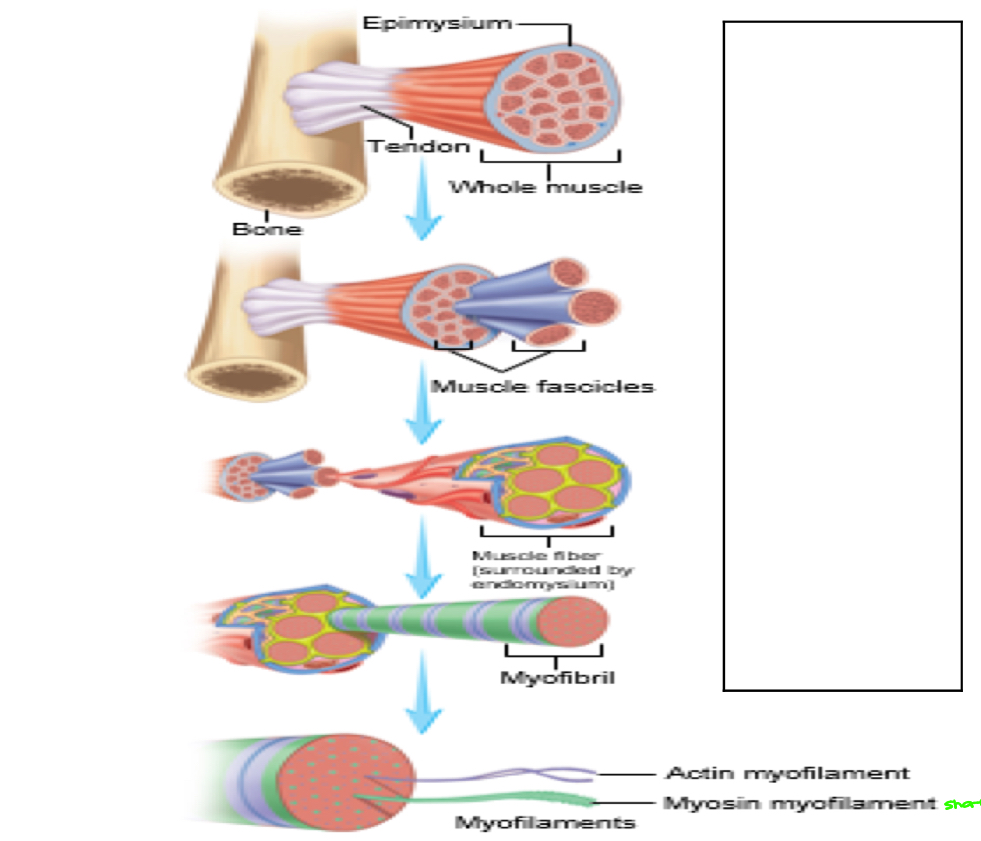
Components- the triad
Significance of T-tubule? **AP to go deep!! Ca++ gets out! Troponin binds the Ca++
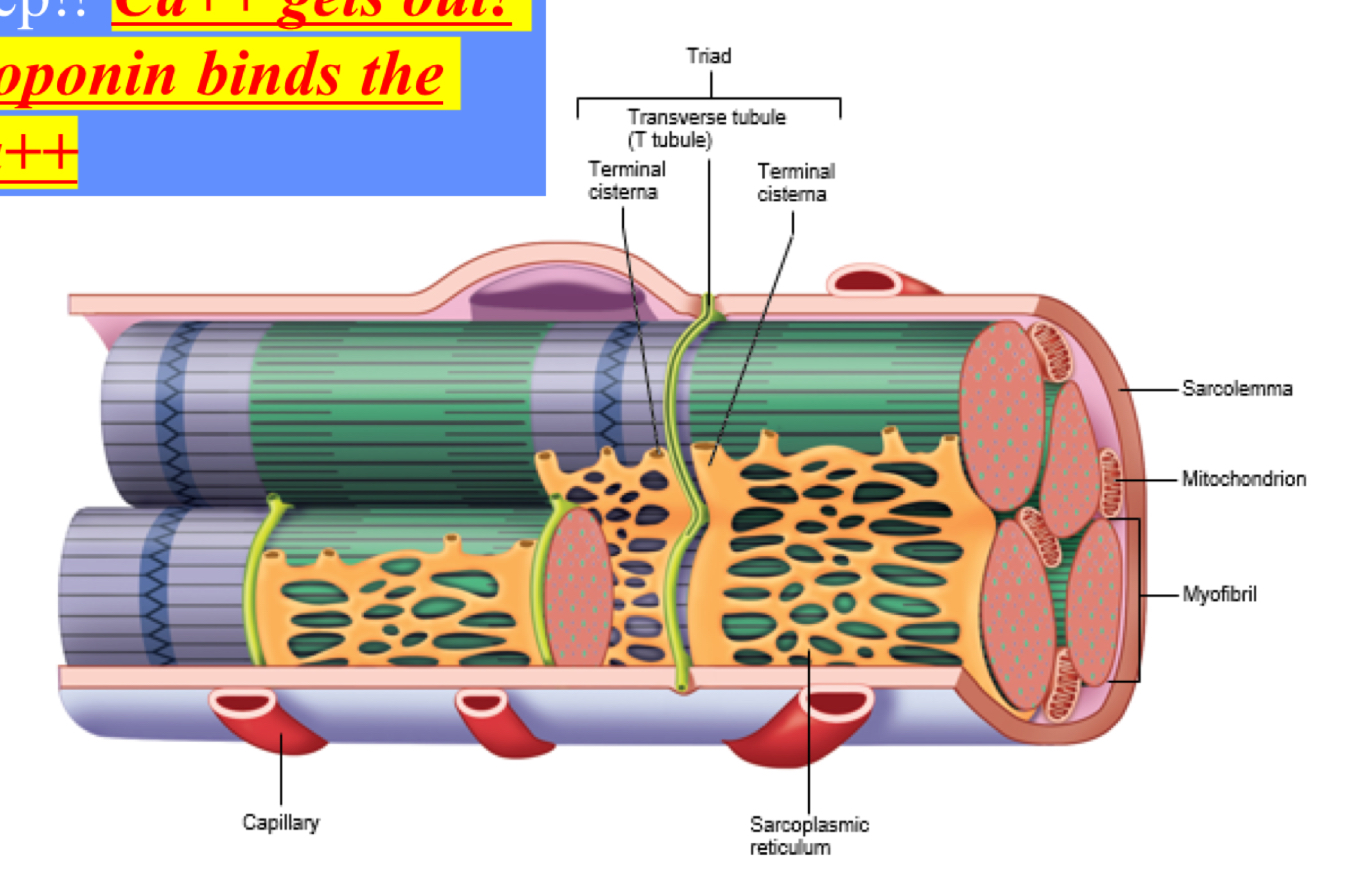
Sarcomeres- structure and function
Molecular interaction facilitates conformational change!! Myosin = Myosin ATPase
When actin & myosin contract, they do not shorten
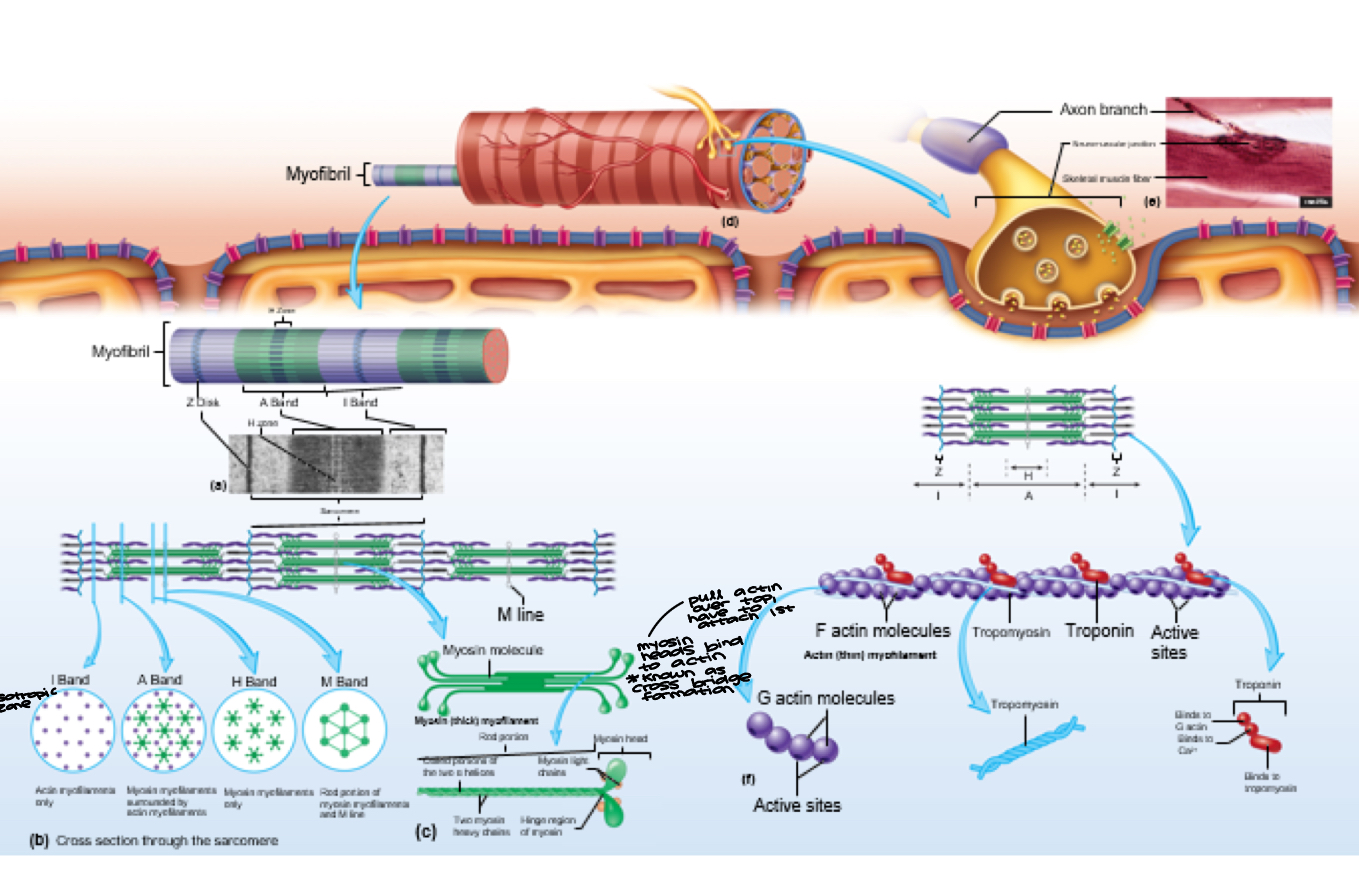
4 Steps of the Muscle Contractile Cycle:
Ca++ is released from sarcoplasmic reticulum & troponin binds the free Ca++. The troponin/tropomyosin complex “moves” thus exposing myosin head binding sites ON actin. When myosin heads bind actin, this is called “cross bridge formation”
The myosin heads will “pull” actin over the top of the myosin. This is called the “power stroke.” Remember, actin and myosin do NOT shorten during muscle contraction! Actin and myosin contract “over” the top of each other = **Sliding Filament Theory! Ref to maximum overlap of actin and myosin WITH space to generate power
****A new ATP binds to myosin heads. This causes the myosin head to detach from actin! OK, NOW, what would happen if one were OUT of AT{ with regards to step 3? CRAMPS (**gastroc) vs Rigor Mortis!!!
If we want myosin to let go, we need new ATP to bind… detach
Myosin (short for “Myosin ATPase”) can not ONLY BIND ATP, but can hydrolyze ATP to ADP + PO4 which “recocks” the myosin head so that it can re-attach to another actin molecule! Now, we need to think of a muscle contraction as a *****”Tug-O-War”!!!
ATPase: 1° AT, +∆G → -∆G
recock: ATP hydrolysis
Cross bridge formation- Myosin- head cycling

Relaxed sarcomere can shorten to varying degrees up to maximum (tetanus)
Very important we understand exactly does and does not shorten during contraction! H-zone, I-band and the actual sarcomere DO shorten
sarcomere: one z-line to another z-line
A-band (length of myosin), actin and myosin do NOT shorten!
**Twitch (smallest unit) → Tetany! (max state)
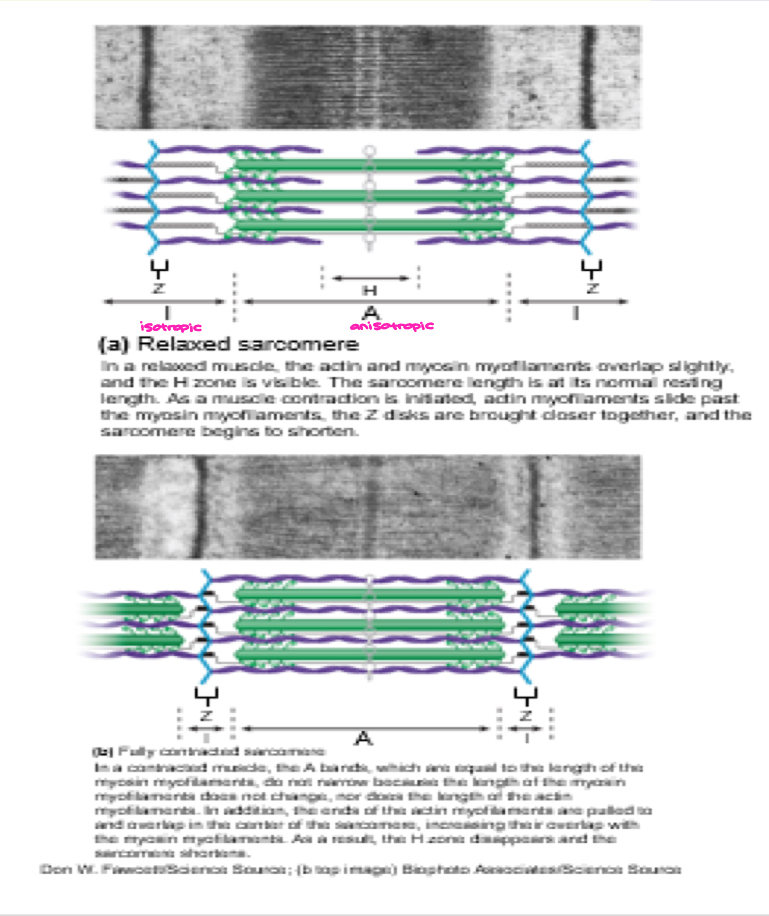
Electromechanical coupling
Tension developed via filament sliding is SQUID!!!!! predicated on an electrical impulse (AP) that radiates from the NMJ- Research done by Hodgkin & Huxley on long axon from squid
figured out that it was (-) charged inside the cell and (+) charged outside
2 big players: Na+/K+ ATPase pump. When we generate AP, we see Na+ coming in (depolarization), K+ going out
ATP hydrolysis can be couple… can take things that are +∆G, which don’t want to happen/not going to happen thermodynamically → -∆G
-∆H, +∆S
In other words, somehow contraction is coupled to a prior electrical signal
To understand this we first need to understand the basic electrophysiology of a skeletal muscle cells (fiber)
Resting membrane potential- RMP → AP
all 4 tissue types have RMP… usually the inside of the cell is (-)
only excitable tissues (2) can use RMP to generate AP… ATPase (think 1° AT)
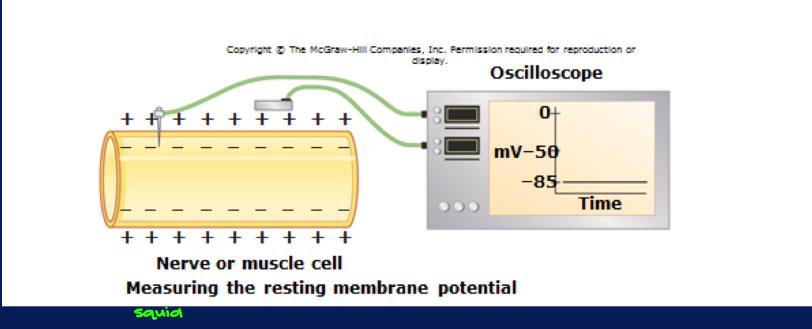
What ions and membrane proteins orchestrate the resting membrane potential?
NOTE- There is also a Na+ Leak Channel. This channel is important in the “pacemaker” of the heart as it promotes the rhythmic impulse of the heart (specifically in the sino-atrial node)- Vagus (X)- parasym; Heart rate??
Na+ leak channel leaks Na+ in… voltage gated calcium in terms of pacemaker’s depolarization
vagus nerve: instead of beating twice per second (120 bpm in adults, too high), it beats once… good for us
parasympathetic fiber to pacemaker of the heart, going to slow it down (vagal tone)
vagal means to wander… vagus goes all over the place
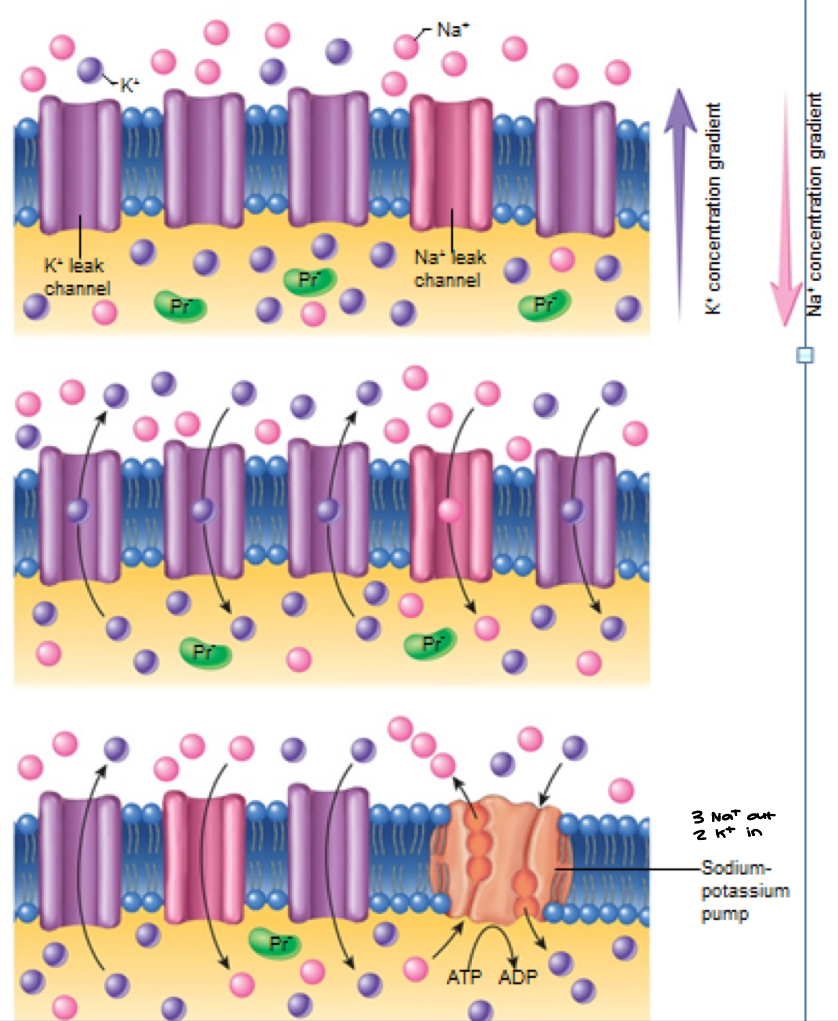
NMJ synaptic anatomy/physiology
Reference to acetyl choline receptor (Ach); *Sarin nerve gas, SSRI’s and Botox here;
sarin nerve gas: irreversible acetylcholine-esterase competitive inhibitor. Ties acetylcholine-esterase up… acetylcholine goes way up (enzyme that breaks it down is rendered inoperable). Skeletal muscles contract so forcefully, muscles break
SSRIs: selective seratonin reuptake inhibitors. SSRI → legal (blocks only brain).
SSRI → not legal (ex: methamphetamines). Antidepressants, only blocking seratonin reuptake in brain, takes weeks to build-up. Inhibitors are antidepressantsbotox: blocks group of proteins known as the snaps & snares
*Pharmacology discussions after SB (3)!
acetylcholine-esterase is enzyme that breaks down acetylcholine, NT of choice in NMJ
112 = venoms/toxins/poisons
interfere w/ voltage gated Ca++ channels, some necrosis
CPL friend has been bit twice by timber rattlers… has venom (fainted)
keep voltage gated Ca++ channel open; BP & resistance drop, system vasodilation
convergence evolution, analogous traits… evolve independently
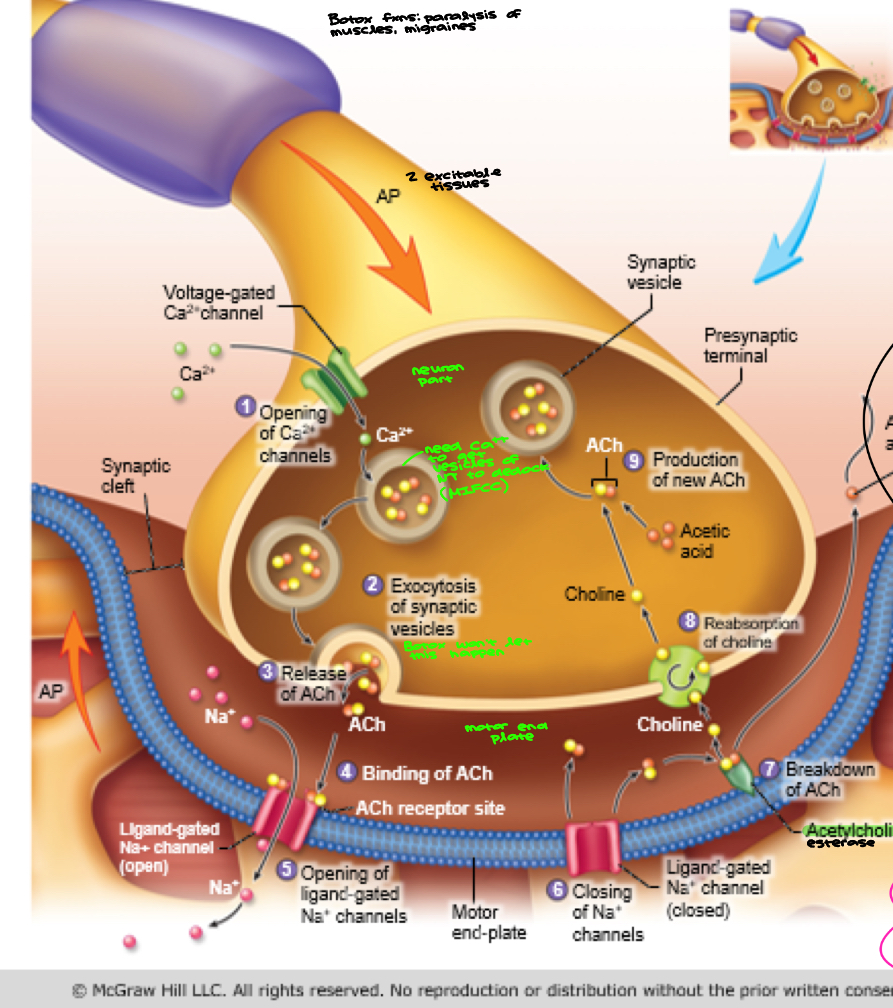
Botox
**SNAPs & SNAREs**- Vesicle of NT can bind to pre-synaptic membrane then exocytose contents into synapse; BOTOX interferes with this! Result?? **Botox → Migraines
botox interferes w/ SNAPs & SNAREs, need the to get vesicles of NT to dock
to get NT to bind, fuse, & exocytose, botox is going to mess around w/ SNAPs & SNAREs
acetylcholine dec., paralyzes muscles
botox: vesicles of acetylcholine cannot be released, paralyzes muscle… helps w/ migraines
NOTE- Role of Ca++ in NT vesicle de-docking
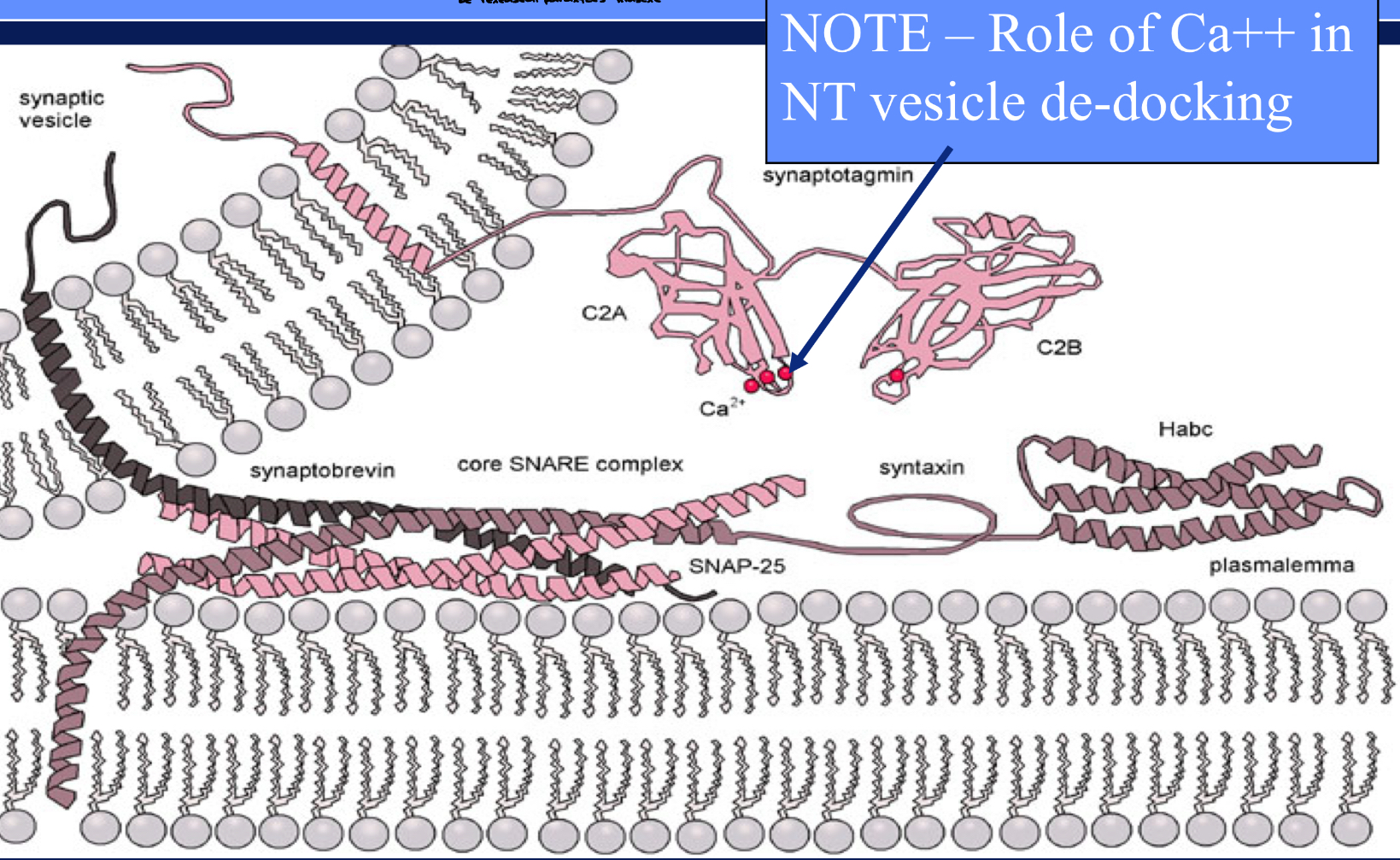
How voltage gated ion channels ***(open & close = “gates”)
Orchestrate depolarization/repolarization of an action potential
massive intracellular K+ concentrations… wants out
massive extracellular Na+ concentrations… wants in
have gates, can swing open & closed
depolarization is Na+ channel opening, Na+ coming in… inside of cell more (+)
repolarization… voltage gated K+

The action potential waveform and propagation - Hodgkin & Huxley (exps)
Neuron AP & skeletal muscle AP look the same, just different #’s
To get to RMP… Na+/K+ ATPase pump & slow leak K+ channel
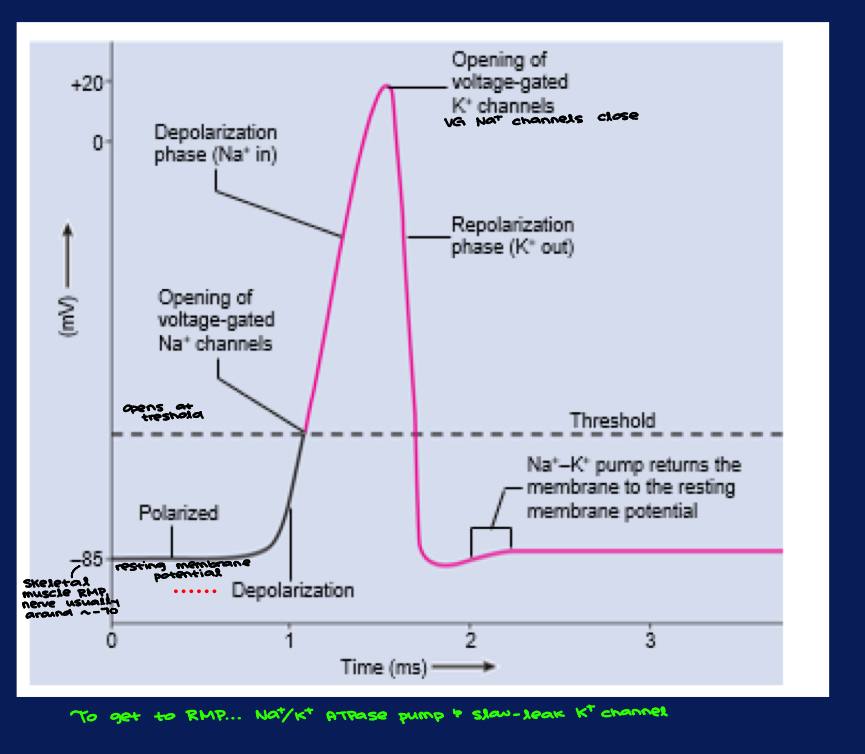
The action potential waveform and propagation - Hodgkin & Huxley (exps) pt.2
PIC ON EXAM
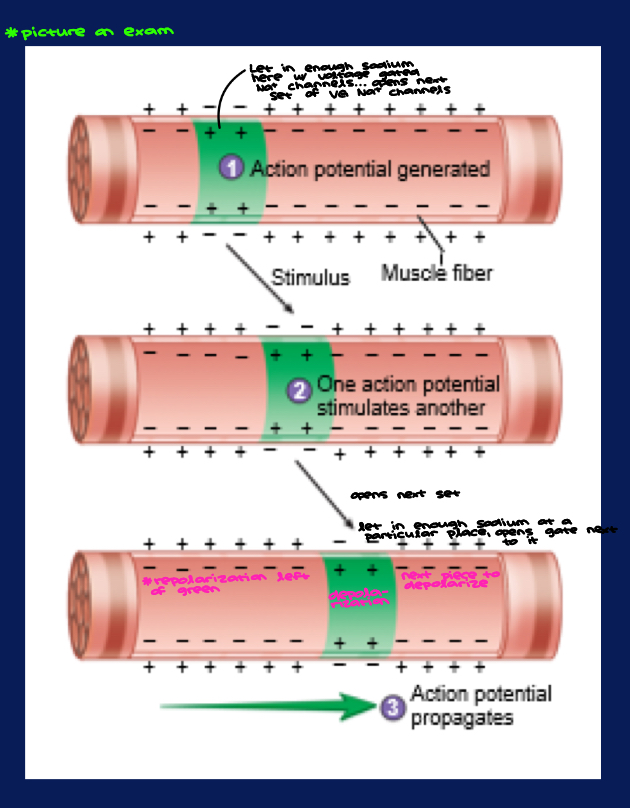
AP stimulates Ca++ release from terminal cisterns; Uptick in sarcoplasmic Ca++ sets in motion the interaction of thick filaments with thin filaments
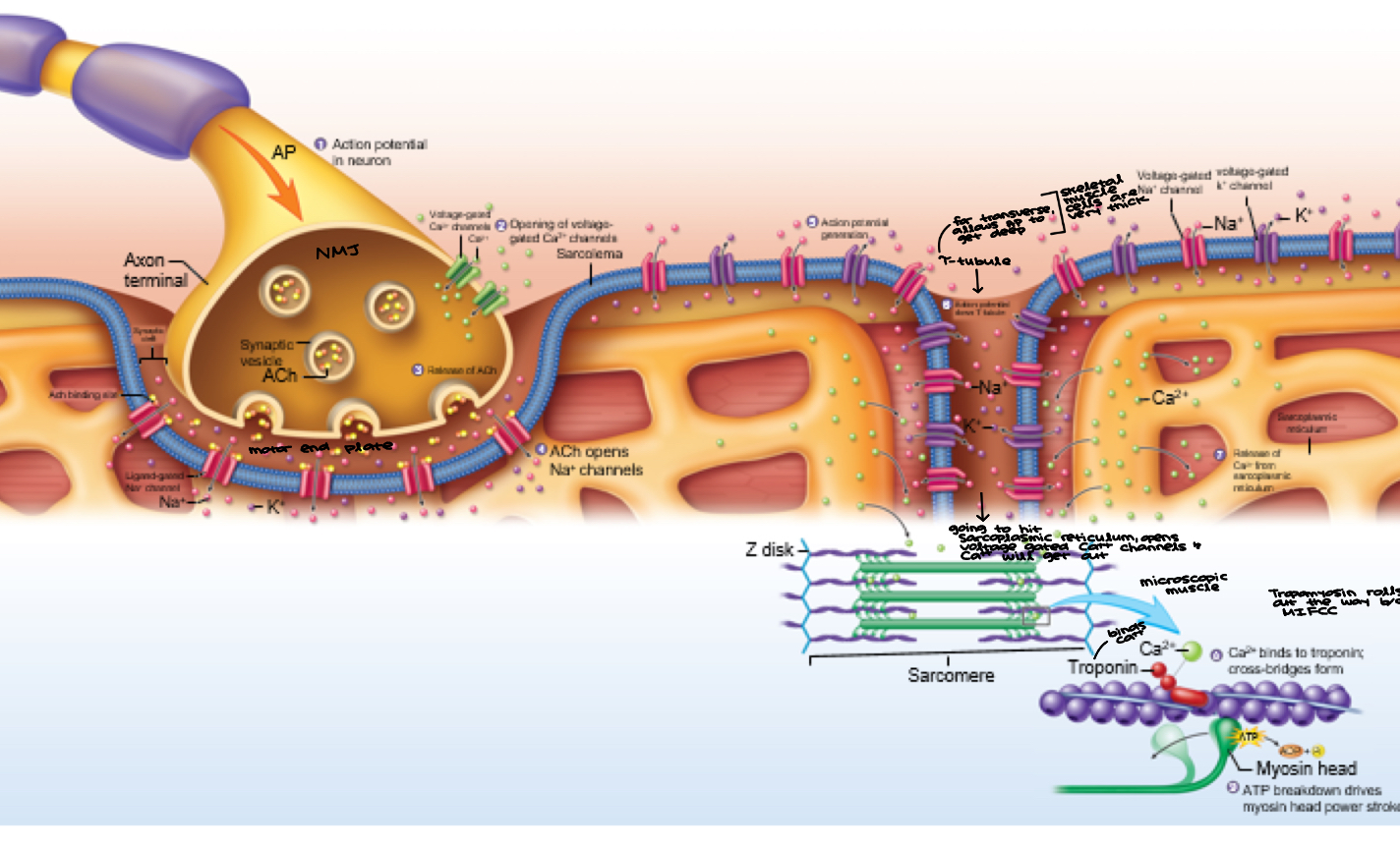
Repeated headcycling leads to sarcomere shortening
B/c they are striated… actin & myosin are arranged in a particular conformation
Striations come from A-band, I-band, A-band, I-band
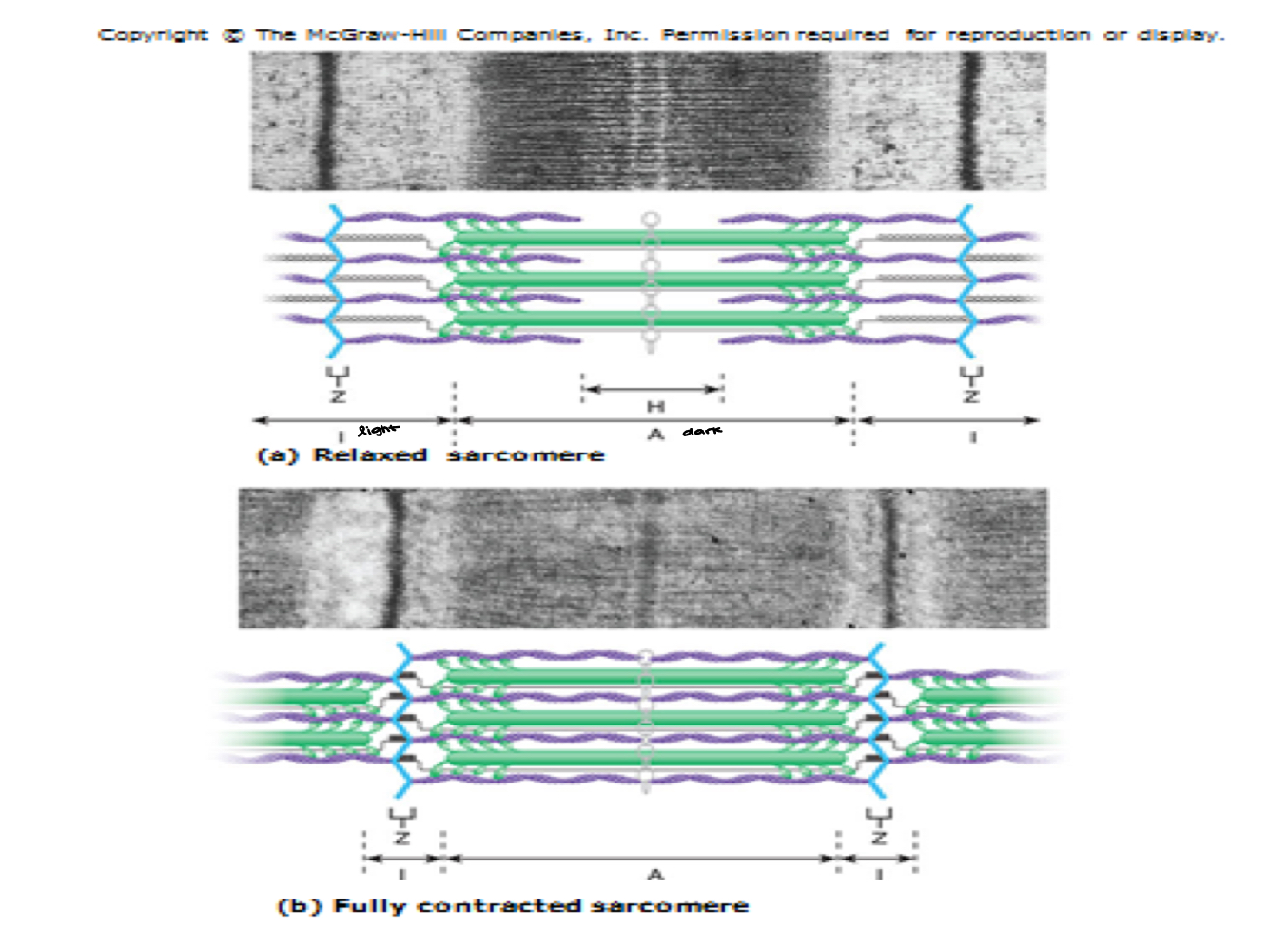
Muscle soreness. There are MANY different causes of muscle soreness (over usage, injury, certain viruses → interferons!, etc.) including the muscle being sore for NO reason at all due to tension and stress
Three Basic Types of Muscle Soreness:
IMMEDIATE- The muscle burns during the actual act of muscle contraction. Ex.- “***Wall sits and quadriceps are ON fire!”. ***Lactate to **liver = *Cori Cycle
lactic acid can be shuttled out of skeletal muscle cells, going to end up in liver
on fire b/c of lactic acid (immediate burn)
cori cycle changes lactic acid back to pyruvate
24-48 Hours After Heavy Lifting or Over-Exertion- Leads to tiny micro-tears in the muscle; Needs to be repaired (**testosterone levels go UP in both genders) → ****satellite stem cell recruitment (**adding nuclei = more txpn and translation of ***A&M) true muscle building!) vs ***creatine (bloated muscle!)
testosterone is good at promoting satellite stem cell recruitment, good at fixing micro teats
20 or more hours of strenous exercise → creatine. Under influence of creating kinase… adds phosphate. Creating phosphate can donate phosphate group to ADP so we can regenerate ATP faster
Soreness that Lasts for Weeks- This type of soreness is usually extreme overexertion couples with engaging in activity the body has NOT adjusted to previously; Ex. Playing 11 softball games in ONE DAY when your body is really only trained to play in perhaps 1 or 2 games in one day; tendons and ligaments are “stretched: and that repair can take an extended period of time because reduced blood flow to those tissues may delay repair
****Cartilage, tendons, and ligaments is VERY SLOW to repair and may require surgery to expedite healing!
not usually 6-8 cells away
don’t get truckload of blood… slow to repair
get contorted due to excessive usage
Myopathy
In medicine, ***myopathy is a disease of the muscle in which the muscle fibers do not function properly. This results in muscular weakness. Myopathy means muscle disease (greek: myo- muscle + patheia- pathy : suffering). This meaning implies that the primary defect is within the muscle, as opposed to the nerves (“neuropathies”) or “neurogenic” disorders) or elsewhere (eg. the brain). Muscle cramps, stiffness, and spasm can also be associated with myopathy
when something isn’t working right… in muscle world → myopathies, neuro world → neuropathies
Capture myopathy can occur in wild or captive animals, such as deer and kangaroos, and leads to morbidity and mortality. It usually occurs as a result of stress and physical exertion during capture and restraint
*****Q. Muscular disease can be classified as ***neuromuscular or ****musculoskeletal in nature → Genetics → Environment → Virus (***interferons (virus- induced..**COVID19.. inflammation of lung.. swelling… fluid… drowning) = ***turn on *****p53; achy!!!).Bacterial exotoxins (Lyme Disease)*******P53 functions (**5) = DNA repair, regulation of cell division (halt cell division temporarily), Apoptosis, **Senescene (mitotic activity permanently halted), Immune sys act UP!!
COVID19 binds to ACE2 receptor of HR1… usually deep in lungs & then inflammation kicks in, don’t have gills… fluid build-up
interferons: achey feeling (defense) when we get sick, important in terms of being an antiviral compound
lyme disease: bacterial infection, vector → tick carries it around… embedded on top of head? CPL knows 2 personally (lone star tick)
5 things P53 does should it mutate… not a protein
plays a big role in helping our immune system function properly
*****50% of human cancers have a mutated p53 gene!*****
Some conditions, such as myositis (rare but is inflammation of muscle associated with infection, autoimmune activity, medicines, and injury), can be considered both neuromuscular and musculoskeletal
What us muscular dystrophy?
Muscular dystrophy (MD) refers to a group of more than **30** genetic diseases (***paradigm shift****) that cause progressive weakness and degeneration of skeletal muscles used during voluntary movement. These disorders vary in age of onset, severity, and pattern of affected muscles. All forms of MD grow worse as muscles progressively degenerate and weaken. Many individuals eventually lose the ability to walk. Although MD can affect several body tissues and organs, it most prominently affects the integrity of muscle fibers
paradigm shift: Thomas Kuhn, History of Scientific Revolution *in the science world… new technologies lead to new info, new conclusions/analysis based on advances in technology
not afraid to change our mind in science based on evidence
everything we thought to be “true” in science, we later disprove it
*****The disease causes (Roman Numeral Question):
Muscle degeneration
Progressive weakness
Fiber death (****myofiber, myocytes, and muscle cell = SAME)
Fiber branching and splitting
****Phagocytosis (***autoimmune disorders; antibody → macrophage!!) (muscle fiber material is broken down and destroyed by scavenger cells)
Chronic (long-term) vs acute (short-term) or permanent **shortening of tendons and muscle. Also, overall muscle strength and tendon reflexes are usually lessened or lost due to replacement of muscle by connective tissue and fat
when antibody binds to us in an autoimmune disorder, macrophages are going to come right behind it & devour it
antibody attacks is, when looking at TEM or SCM, looks like letter Y (Ig: M, A, D, E, G)
phago: eat, cyto: cell, osis: condition of